Weber 2V carburettor - removal and refitting
Note: Refer to the warning at the end of Section 1 before proceeding.
XR3 models
Removal
1 Disconnect the battery negative lead.
2 Remove the air cleaner as described in Section 2.
3 Disconnect the electrical leads at the electric choke and anti-run-on valve (see illustration).
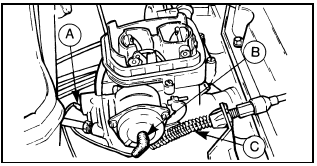
16.3 Weber 2V carburettor disconnection points - XR3 models
A Anti-run-on valve lead
B Electric choke lead
C Throttle cable
4 Disconnect the vacuum pipe at the carburettor outlet.
5 Disconnect the throttle cable by releasing the spring clip securing the end fitting to the ballstud, and unscrew the cable bracket fixing bolts.
6 Disconnect the fuel inlet and return hoses, noting their respective positions, and plug them after removal. If crimped type clips are used, cut them off and use screw type clips when refitting.
7 Undo the four mounting flange nuts and washers and withdraw the carburettor from the inlet manifold.
Refitting
8 Refitting is the reverse sequence to
removal, but use a new flange gasket and
ensure that the mating surfaces are perfectly
clean. Make sure that the vacuum pipe fuel
trap is correctly positioned, and on
completion check the idle speed and mixture
settings as described in Chapter 1.
1.4 litre models
9 The procedure is identical to that just
described for XR3 models except that a
manual choke is fitted and the choke inner
cable must be released by slackening the
linkage clamp bolt.
10 Additionally when refitting, observe the following points.
a) Adjust the choke cable as described in Section 9.
b) Where applicable, the lead for the antirun- on valve should be removed from the metal clip which secures it to the carburettor body, re-routed as shown, and taped to the vacuum hose (see illustrations). The metal clip should be discarded, and the securing screw refitted to the carburettor body, ensuring it is fully tightened.
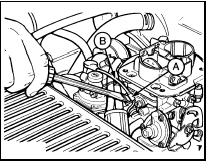
16.10a Removing the metal clip (A) securing the anti-run-on valve lead (B)
1.4 litre models
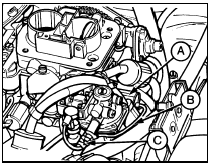
16.10b Correct routing of the anti-run-on valve lead - 1.4 litre models
A Anti-run-on valve
B Lead
C Lead taped to
vacuum hose
1.6 litre models - 1986 onwards
Removal
11 Disconnect the battery negative lead.
12 Remove the air cleaner as described in Section 2.
13 If the engine is still hot, depressurise the cooling system by carefully releasing the pressure cap (see Chapter 1).
14 Disconnect the coolant inlet and outlet hoses at the automatic choke and clamp or plug their ends to prevent coolant loss.
15 Disconnect the throttle cable by releasing the spring clip securing the end fitting to the ball-stud, then unscrewing the cable bracket fixing bolts.
16 Disconnect the fuel inlet and return hoses, noting their respective positions, and plug them after removal. If crimped type clips are used, cut them off and use screw type clips when refitting.
17 Disconnect the distributor vacuum pipe and the throttle kicker vacuum pipe on automatic transmission models.
18 Disconnect the electrical lead at the antirun- on valve solenoid.
19 Using a suitable Torx type key or socket bit, unscrew the four mounting through-bolts from the top of the carburettor and remove the unit from the manifold (see illustration).
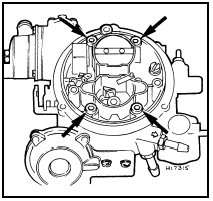
16.19 Weber 2V carburettor mounting through-bolt locations - 1.6 litre models
Refitting 20 Refitting is the reverse sequence to removal, but use a new flange gasket and ensure that the mating faces are perfectly clean. On completion top-up the cooling system as described in “Weekly checks” and check the idle speed and mixture settings as described in Chapter 1.
1.1 and 1.3 litre HCS engine
models
Removal
21 Disconnect the battery negative terminal.
22 Remove the air cleaner as described earlier.
23 Disconnect the throttle and choke cables as described in the relevant Sections.
24 Disconnect the fuel inlet hose. If crimped connections are used cut them off and renew them with screw type clips.
25 Disconnect the lead at the anti-run-on valve solenoid (see illustration).
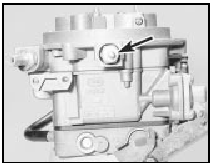
16.25 Anti-run-on valve solenoid (arrowed) - 1.1 and 1.3 litre HCS engines
26 Remove the four Torx type through-bolts securing the carburettor to the inlet manifold (see illustration).
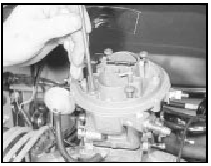
16.26 Removing a Torx through-bolt - 1.1 and 1.3 litre HCS engines
27 Lift off the carburettor (see illustration).
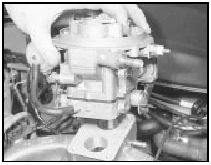
16.27 Lifting off the carburettor - 1.1 and 1.3 litre HCS engines
Refitting 28 Refit in reverse order using a new flange gasket.
29 On completion check the idle speed and mixture settings as described earlier.
See also:
Tailgate - removal and refitting
Removal
1 Remove the trim panel (Section 32).
2 Disconnect the wiring from the heated rear
window element, radio aerial, wiper motor
tailgate speakers and tailgate lock motor as
applicable (see i ...
Identifying components in the engine compartment
2.0L DOHC Zetec engine
Transmission fluid dipstick (automatic transaxle)
Battery
Air filter assembly
Engine oil filler cap
Engine oil dipstick
Power steering fluid reservoir
Engine ...
Brakes
Your service brakes are self-adjusting. Refer to the scheduled
maintenance guide for scheduled maintenance.
Occasional brake noise is normal and often does not indicate a
performance concern with ...
